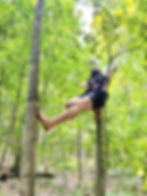What is my Movement Therapy Session Like?
- Alex Schenker
- May 24
- 3 min read
The foundation of my treatment method is Shiatsu and Sotai therapy, which also include complimentary self-care exercises. This involves deep pressure with the thumbs, fingers and palms, assisted stretches and joint mobilizations, as well as structural alignment techniques that involve a more active involvement. These sessions include assessment, treatment, and instruction and coaching in simple self-care recommendations. These recommendations may include lifestyle adjustments, most specifically regarding postural habits, and suggested corrective exercise routines to maintain between treatment sessions.
With Shiatsu and Sotai, treatment and assessment are one. Throughout our treatment session, palpating and moving the body reveals to me the weaknesses and antagonistic abnormal tensions that are behind your symptoms better than any normal visual screen can. From this deep hands-on analysis accompanying, the most appropriate self-care exercises can be recommended. When assessment is done with this level of precision, very few exercises are needed. What's more important, in order to maintain the momentum of healing, is consistency. The self-care exercises draw from the following modalities:
One element that makes my approach unique, is the inclusion of retraining our natural movement patterns, along with the more specific therapeutic focus of self-treatment methods, and the more flexibility focus of the mobility methods, together in a perfectly complimentary package.
Treatment alone, with any modality amounts to little more than symptom management if you are not including at least a bare minimum self-care routine, which involves a commitment of less than 10 minutes per day of movements that transform your body by means of postural alignment, and restoring natural range of motion. Without addressing the damage that sedentary lifestyles, activities that are harsh on the joints, and habitual self-destructive patterns have on our body through a routine that is focused on your specific imbalances, getting a treatment once or twice per month has but a shadow of the potential to make lasting changes, no matter the modality. Yoga classes, and general training that is not specifically focused on your unique imbalances and condition can feel good, and make some superficial improvements, but will not address your deeper fundamental issues effectively.
Through movement therapy modalities like Shiatsu & Sotai, I can specifically feel the patterns that need to be addressed at a level that a professional who is simply watching you move can not perceive. The combination of movement therapy, and crafting a mobility training program goes deeper than conventional approaches. Decades of developing my method through my own personal practice has produced an angle of expertise that you won't find anywhere else.
Japanese Manual Therapy

Sotai & Shiatsu are both manual therapy modalities emerging from Japan. They combine both modern medical science with deeply effective traditional healing methods based on the meridian system. They are deeply effective therapies for treating abnormal pain and tension in the body, restoring postural alignment, facilitating healing after an injury, treatment of chronic issues, and as a potent preventative medicine.
Shiatsu Movement Therapy

Shiatsu involves mainly thumb, finger, and palm pressure, not only to a problem area, but also to distal parts of the body that have a connection to the problem. Shiatsu also involves assisted stretching, and techniques where the therapists moves your joints passively through a certain range of motion.
Sotai Structural Alignment Therapy

Sotai is an active treatment method. It involves comparing two movements to determine which is less strenuous, then the recipient moves their body in that direction while the therapist applies gentle resistance. This is all synchronized with respiration, and guided by the therapist, and the result is a reeducation of the neuromuscular system and the improvement of a person's postural alignment and tension patterns.
Kenbiki Tendon Alignment Therapy

Another modality worth mentioning that is part of Alex's practice is Kenbiki Therapy, a method of treatment that addresses the alignment of tendons. This is a very effective compliment for Shiatsu and Sotai, especially when addressing acute injuries such as sprains, but is not something that is necessarily used in most treatments.

A note from Alex:
If there's one thing I have learned in my two decades as a professional Shiatsu & Sotai therapist, it's that we cannot fix our problems without changing the lifestyle habits that are distorting them in the first place. This involves understanding the fundamental principles of movements and shifting weight, and continually adjusting the few exercises recommended for your daily practice to restore balance in your body. If you're ready to harmonize your imbalances and correct the distortions in your body, I'm here to guide you and help you break through the plateaus that you will face along the way.

